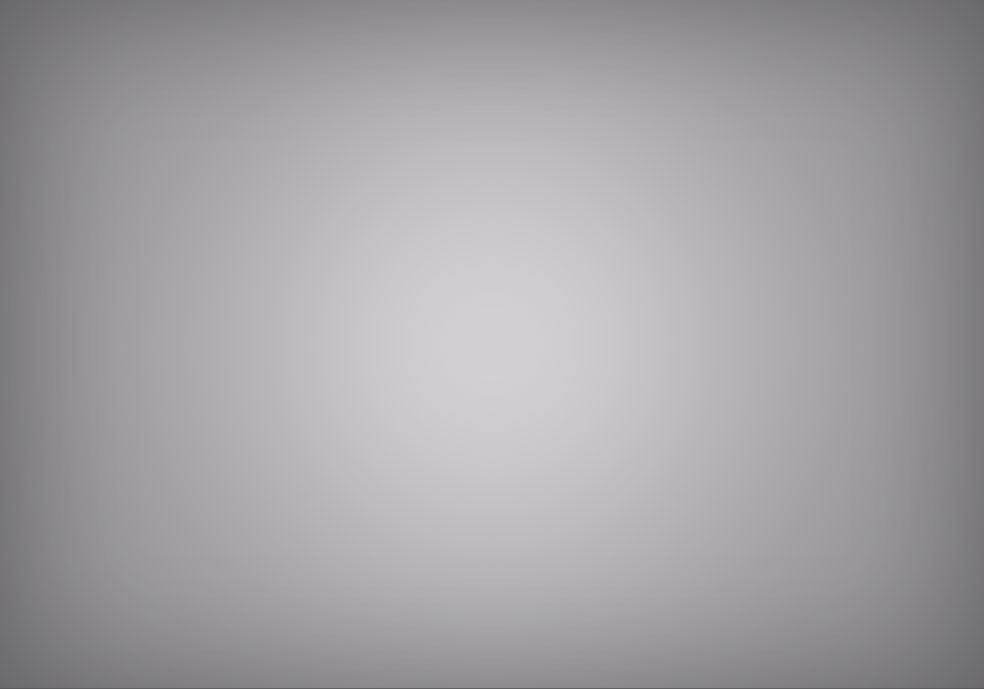Put on Your Shades
by Laura Barnett Sawchyn, IIDA TCW

CLICK TO SEE IMAGE
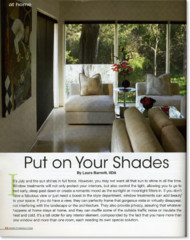
CLICK TO SEE IMAGE
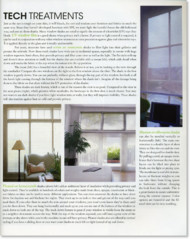
CLICK TO SEE IMAGE
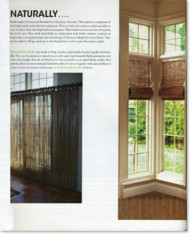
CLICK TO SEE IMAGE
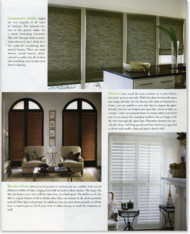
CLICK TO SEE IMAGE
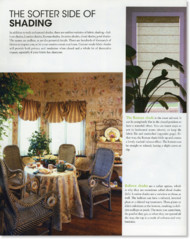
CLICK TO SEE IMAGE
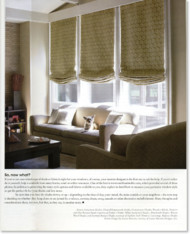
CLICK TO SEE IMAGE
It's July and all the sunshine and warmth we were praying for since last November has finally arrived in full force. However, you may not want all that sun to shine in all the time. Window treatments will not only protect your interiors, but they control the light — allowing you to go to bed early, sleep past dawn, or create a romantic mood as the sun or moonlight filters in. If you don't have a fabulous view or just need a boost in the style department, they can add beauty to your space. If you do, they can perfectly frame that gorgeous vista or virtually disappear, not interfering with the landscape or the architecture. They also provide privacy assuring that whatever happens at home stays at home, and they can muffle some of the noise from by-passing traffic or insulate the heat and cold. It's a tall order for any interior element, compounded by the fact that you have more than one window and more than one room, each needing its' own special solution.
TECH TREATMENTS
Just as the sun is tough on your skin, it will bleach, dry out and weaken your furniture and fabrics in much the same way. Since they haven't developed furniture with SPF (sun protection factor), we must fight the harmful forces the old fashioned way, and put on those shades. Many window shades are rated to signify the amount of UV (ultraviolet) rays that they block. UV window film is a good choice when privacy isn't a factor. If privacy or light control is required, it can be used in conjunction with any other window treatment as extra precaution against glare and ultraviolet rays. It is applied directly to the glass and is totally undetectable.
For years, museums have used scrim or sunscreen shades to filter light into their galleries and protect the art work. Now these mesh shades have wide use in residential spaces, especially in rooms with huge window expanses. They are semi-sheer, provide privacy, and filter your view as well as the light. The flat style rolls up and doesn't draw attention to itself, but they also are available with a roman fold which adds detail to the shade when down and stacks the fabric at the top when the roman is in the up position.
The room in this shot has a beautiful view of the woods. Believe it or not, you are looking at the view through the sunshades! Compare the two windows on the right to the first window right over the chair. The shade in the first window is partly down. You can see perfectly, without glare, through the top part of the window, but look at all the harsh light coming through the bottom of the window where the shade isn't. Imagine all the damage being done to the fabric on that chair without the UV protection of the shades.
These shades are dark brown, which is one of the reasons the view is so good. Compared to the view in photo #2, which pictures white sunshades, the landscape in shot is much clearer. You may not want to use dark shades if you have light window trim or walls, but they will improve visibility. These shades will also insulate against heat or cold and provide privacy.
Pleated or honeycomb shades add an additional layer of insulation while providing privacy and light control. They are available in hundreds of colors and weights made from sheer, opaque, translucent, or blackout fabrics so they can be used in many different applications. You can even construct the shades to have sheer fabric for daytime use and blackout for nights. They stack up to an inch or two and get out of the way until you need them. If you color them to match the trim around your windows, you won't even know they are there until you let them down. They can be hung horizontally and stack up so you can see out of the bottom of the window or stack down to look out of the top. The stackdown feature is great if your window is visible from the street or to a neighbor downstairs across the way. With the top of the window exposed you still have a great view of the tree tops or sky above while you let the sunshine in and still have privacy. Pleated shades also are offered in vertical styling — in case you have a sliding door or you want your shades to stack left or right instead of up and down as in this photo.
Illusion or silhouette shades can also be installed vertically or horizontally. The main construction is a double layer of sheer fabric to filter the sun and the view. They are designed for double duty. By pulling a cord, an opaque membrane that's between the two sheer layers can be tilted into place to block out the light or prying eyes. The membrane is available in translucent or blackout weights so you can take them from living spaces to bedrooms without changing the look from the outside. This is a great feature to assure uniformity along the exterior expanse. Color options are bountiful and the filtered view can be very soothing.
NATURALLY....
Shades made from natural elements have long been time favorites. Their palette is comprised of warm tans, straw tones, browns, and greens. They provide more texture and personality at your windows than their high-tech counterparts. These shades are not meant to disappear, but to be seen. They work beautifully in conjunction with fabric valances, cornices or drapes—but as an equal partner—not something to hide away behind the lovely fabric. They can be made to roll up, stack up or even hang from a rod to open like drapes.
Matchstick shades are made of long wooden matchsticks bound together horizontally. They can be painted or stained in any color and create beautiful light patterns in your room. Surprisingly, they do not block your view as much as you might think, unlike other naturals which are more textural. Sometimes they are woven together with natural fibers to create a variety of textures and become woven wood shades.
Grassweave shades are very popular in all types of interiors. The inherent texture of the grasses makes for a warm, interesting treatment. The view through them is somewhat obscured, but I think it's a fair trade off considering their natural beauty. There are open weaves, closed weaves, multi-colored or solids, but all of them add something extra to the room they are shading.
Wooden blinds can be painted or stained and are available with several different widths of slats, ranging from ½" all the way up to 3". The larger the slat, the better your view will be when they are tilted open. The ability to tilt the slats is a great feature of these shades since they can remain in the down position and still filter light and privacy. In addition, you can raise them partially or all the way to expose part or all of your view. It makes it easy to wash the windows, as well.
Shutters have much the same aesthetic as wooden blinds, but aren't quite as versatile. While the slats also have the same size range and they do tilt, because the slats are housed in a frame, you are unable to raise the slats to expose the glass. Instead, shutters are hinged and open like a door or slide on a track. I only recommend them in rooms where you don't care if you expose the complete window, but are happy with the view through the open slats. "Plantation shutters" are specifically those with large panels and slats as in this photo, as opposed to those with smaller slats and panels that bi-fold.
THE SOFTER SIDE OF SHADING
In addition to "tech" and "natural" shades, there are endless varieties of fabric shading. Balloon shades, London shades, Roman shades, Austrian shades, cloud shades, pouf shades... The names are endless as are the potential details. There are hundreds of thousands of fabrics to inspire you, so let your creative streak run loose. Custom made fabric shades will provide both privacy and insulation when closed and a whole lot of decorative impact, especially if your fabric has character.
The Roman shade is the most tailored. It can be completely flat in the closed position or have a "waterfall" effect. You can insert stays or sew in horizontal seams as in this photo or keep the fabric flat and unstitched as in this photo. Either way, the Roman shade folds up and creates a lovely stacked valance effect. The bottom can be straight or relaxed, having a slight curve, or dip.
Balloon shades are a softer option, which is why they are sometimes called cloud shades. London shades are a variation on these, as well. The balloon can have a tailored, inverted pleat or a shirred top treatment. These pleats or shirrs culminate at the bottom, resulting in definite scallops or poufs. The more you open them, the poufier they get, so when they are opened all the way the top is a crush of softness and very feminine.
SO NOW WHAT?
If you're not sure which type of shade or fabric is right for your windows, of course, your interior designer is the first one to ask for help. If you'd rather do it yourself, help is available from many books, retail, or online resources. One of the best is www.smithandnoble.com who provided us with several of these photos. In addition to presenting the many style options and fabrics available to you, they explain in detail how to measure your particular window style to get the perfect fit for your shades, and lots more.
So now that you have the shades down, or up—depending on the time of day, your mood, the noise outside, or your neighbors—the next step is deciding on whether they hang alone or are joined by a valance, cornice, drape, swag, cascade, or other decorative embellishment. Many thoughts and considerations there, for sure, but as they say, "that is another story."
Click below to download PDF of entire article.
